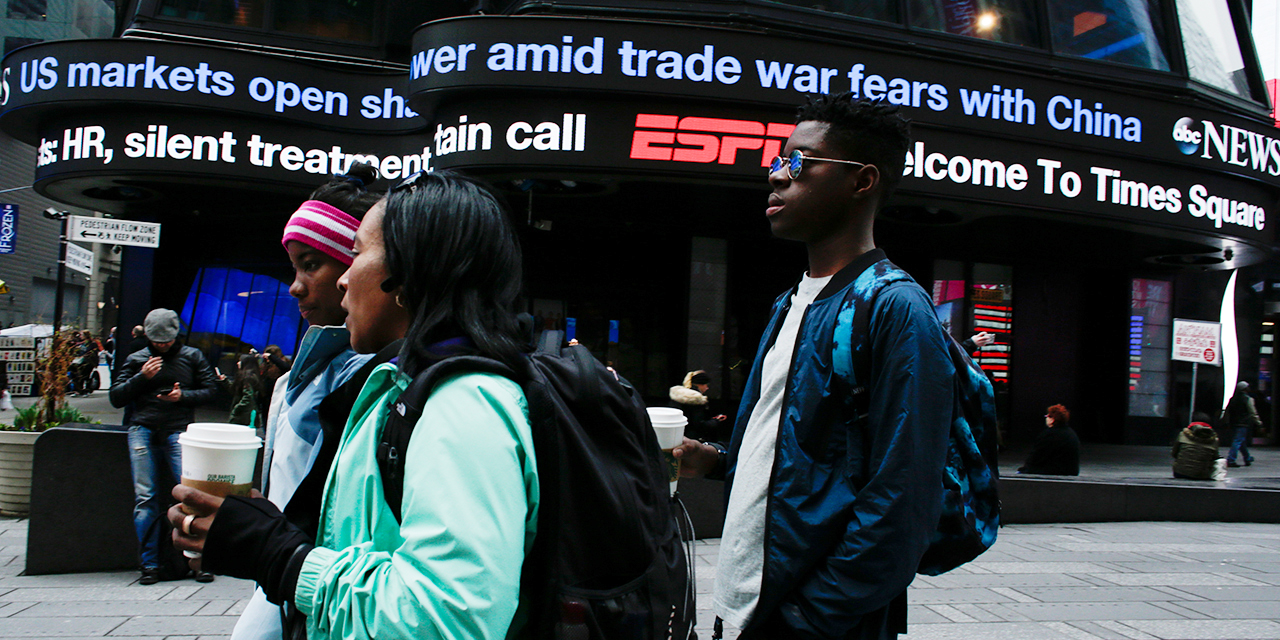
How we did this
This analysis focuses on Americans’ views of China on topics including Chinese leadership, economic standing, military strength and attitudes about the country more broadly. Pew Research Center has been tracking attitudes toward China since 2005. This report also includes demographic analysis comparing groups with different levels of education, age and political leanings, as well as attitudinal changes occurring simultaneously with the spread of the coronavirus.
For this report, we used data from a nationally representative survey of 1,000 U.S. adults conducted by telephone from March 3 to 29, 2020.
Here are the questions used for the report, along with responses and survey methodology.
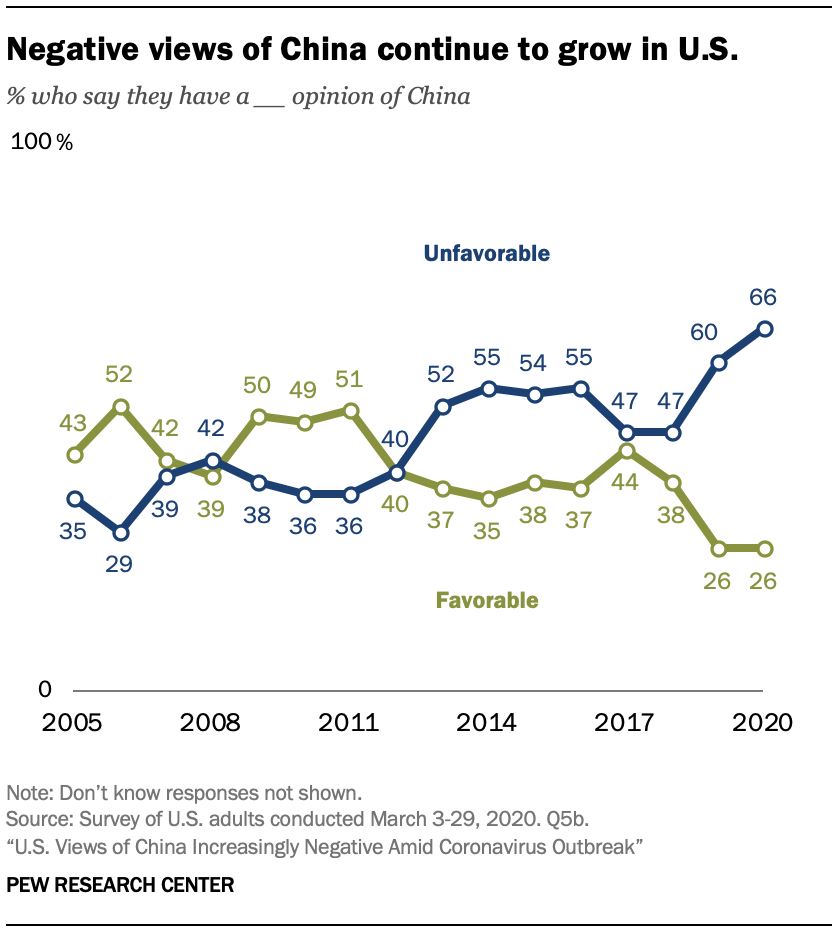
For updated data on American views of China, see here.
Since President Donald Trump took office in 2017, his approach to U.S.-China relations has included increased pressure via tariffs and trade war rhetoric, and now, with the onset of an unprecedented pandemic, the stage has been set for both sides to cast aspersions on the other. Against this backdrop, negative views of China have continued to grow, according to a new Pew Research Center survey of Americans conducted in March. Roughly two-thirds now say they have an unfavorable view of China, the most negative rating for the country since the Center began asking the question in 2005, and up nearly 20 percentage points since the start of the Trump administration. Positive views of China’s leader, President Xi Jinping, are also at historically low levels.
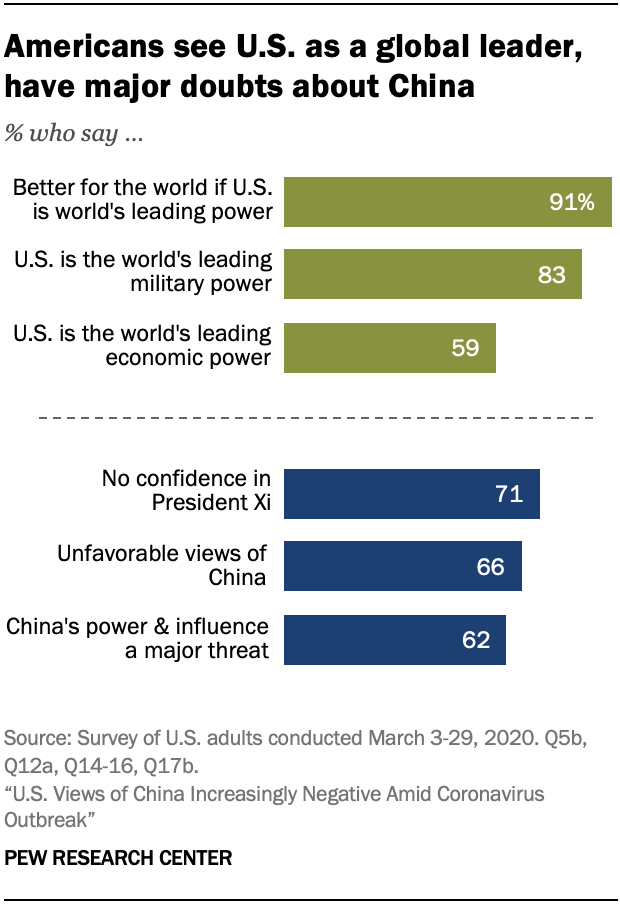
Economic factors, such as job losses to China and the trade deficit, remain key concerns for the American public. But other issues – including Chinese human rights policies and environmental degradation – also worry Americans. Many of these issues play a role in how the public views China more broadly: Those who see the China-related topics included in the study as a serious problem generally have less favorable views of China overall.
As the economies of both China and the United States struggle with the impact of the current pandemic, more Americans now see the U.S. as the world’s leading economic power than at any time over the past 12 years. In fact, Americans now see the U.S. as more of an economic powerhouse than China by roughly two-to-one (59% vs. 30%). Americans also overwhelmingly believe their country leads the world militarily and that the world is better off with U.S. leadership as opposed to that of China.
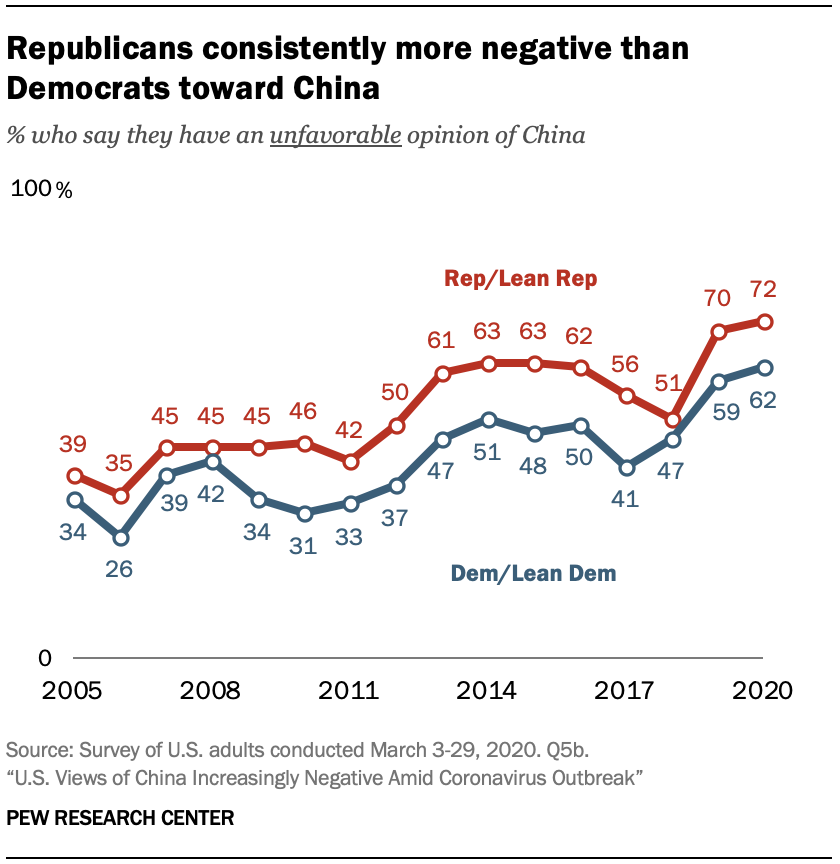
In some ways, this is a partisan story. Republicans continue to be more wary of China than Democrats across many questions in this report. Nearly three-quarters of Republicans and Republican-leaning independents see China unfavorably, compared with roughly six-in-ten Democrats and Democratic leaners. They are also more worried about China when it comes to cybersecurity and economic issues such as job losses to China and the trade imbalance. Republicans are more likely than Democrats to see the United States outpacing China as the world’s leading economic power as well as the world’s top military. And GOP supporters almost universally say it is better that the world be led by the U.S. Still, negative views of China increased slightly among Democrats this year, so partisans of both stripes are now largely negative toward the superpower. In fact, after seeing large increases in negative views of China from 2018 to 2019, both parties registered their most unfavorable opinions to date in 2020.
These are among the findings of a new survey by Pew Research Center, conducted March 3 to 29, 2020, among 1,000 adults in the U.S. The survey also finds that younger people, who have historically been more positive than older Americans toward China, now increasingly hold negative views of the country and are more prone to see it as a threat to the U.S. than in previous years. Older Americans, however, still take a more negative stance than their younger compatriots on most aspects of the U.S.-China relationship.
Unfavorable views of China continue to climb
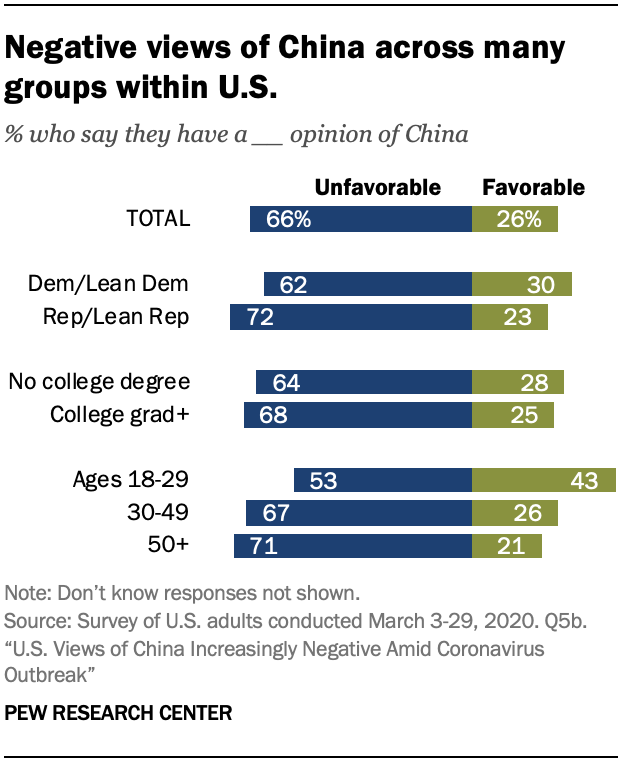
Views of China have soured further in 2020, building on the dramatic uptick in negativity seen between 2018 and 2019. Roughly two-thirds of Americans now have a negative opinion of China, the highest percentage recorded since Pew Research Center began asking the question in 2005. Only about a quarter in the U.S. report a favorable attitude.
The survey took place as the coronavirus outbreak spread throughout the U.S., with several states implementing lockdowns and death tolls multiplying at a rapid clip. While China’s handling of the virus may have made an impression on some Americans, it does not appear that escalating conditions in the U.S. over the course of March shifted attitudes toward China during that period. Views of China did not significantly change when comparing those surveyed before and after March 12, approximately when the NBA indefinitely postponed the remainder of the season and actor Tom Hanks announced testing positive for COVID-19 on social media. Americans interviewed prior to March 13, when the U.S. government declared a national emergency, had equally negative views toward China as those interviewed on or after that date, even when holding constant age, education, gender and political affiliation. (For more on how the Center has dealt with unforeseen events during fieldwork in the past, see “When the Unexpected Happens, What’s a Survey Researcher To Do?”)
Across demographic groups, negative views of China abound. Roughly six-in-ten Democrats and Democratic-leaning independents have unfavorable views of China, as do roughly seven-in-ten Republicans and Republican-leaning independents. Those with a college degree are just as likely as those with less than a college degree to hold negative views of China; roughly two-thirds of each group voice this opinion.
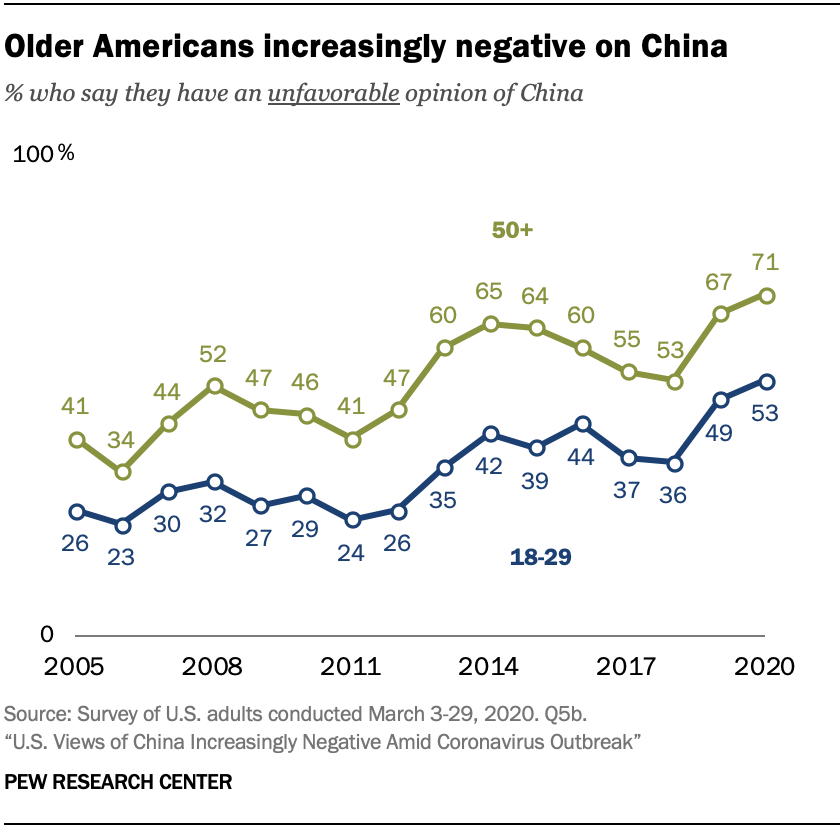
Older Americans, those ages 50 and older, are more likely than those ages 18 to 29 to have unfavorable views of China. This has been the case every year since the Center first asked the question 15 years ago. But while half or more of those 50 and older have held negative views of China since 2012, this is the first year in which more than half of younger Americans also have an unfavorable opinion. Among this age group, negative views have roughly doubled since the question was first asked.
Largely similar patterns emerge by party, with Republicans tending to be more negative than Democrats. Still, both partisan groups – for the second year in a row – have recorded their most negative assessments of China since the Center began asking this question in 2005.
Views of President Xi reach new low in U.S.
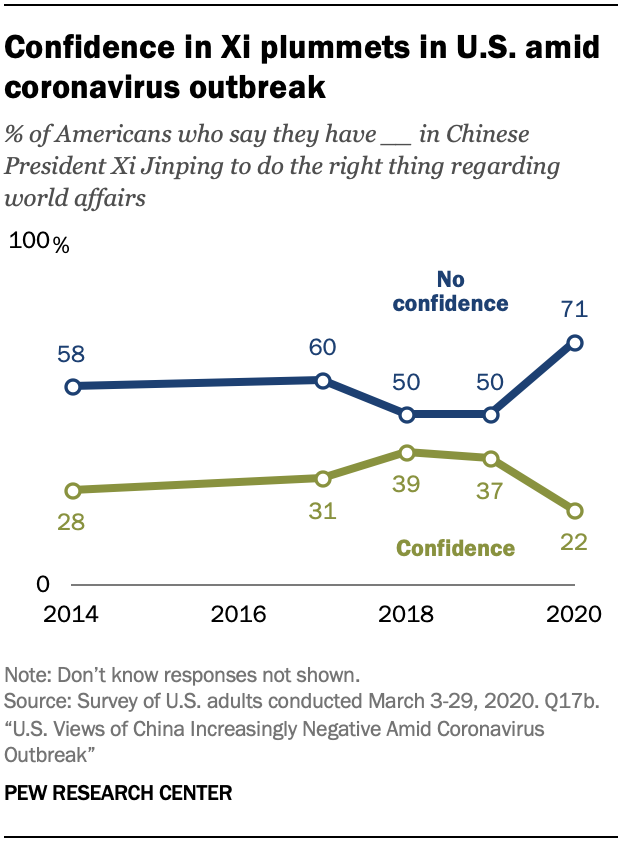
As ratings for China have declined, so too has confidence in Chinese President Xi Jinping. Roughly seven-in-ten Americans (71%) say they do not have confidence in Xi to do the right thing when it comes to world affairs – a high since the Center first asked the question. Just 22% say they have faith in the Chinese leader, down 15 percentage points since last year.
The drop in confidence from 2019 to 2020 is especially notable. While views of Xi have been fairly stable for the past few years, remaining within a 10 percentage point range, in just the last year the percentage saying they lack confidence in him has increased by 21 points. This shift occurred among both Republicans and Democrats, as well as among older and younger Americans.
And while the U.S. president’s rhetoric toward China’s leadership during the outbreak has fluctuated in tone, the American public’s attitudes remained fairly stable over the course of this survey. As with views of China, a shifting news environment over the course of March with regard to the role Beijing played in handling the initial outbreak does not appear to have affected how Americans view President Xi in the short term. Those interviewed prior to the U.S. government declaring a national emergency on March 13 were just as likely as those interviewed later in March to lack confidence in the Chinese leader. This remains true even when holding constant factors including age, gender, education and political affiliation.
Many see Chinese power and influence as threat to the U.S.
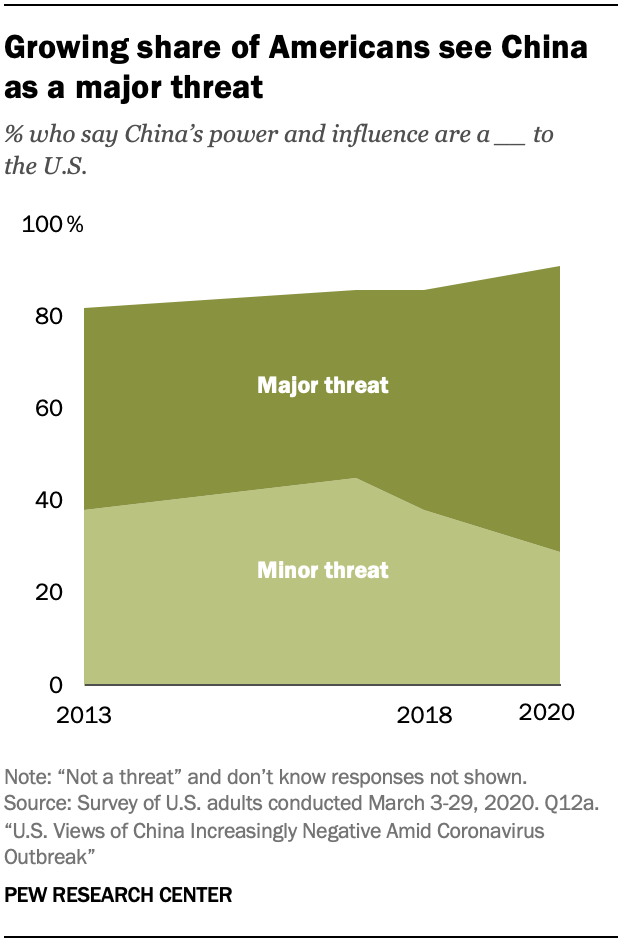
About nine-in-ten U.S. adults see China’s power and influence as a threat – including 62% who say it is a major threat. While the total portion that sees China’s power and influence as a threat has not changed significantly since the question was last asked in 2018, the share perceiving China as a major threat has increased 14 percentage points since 2018.
Older Americans are more concerned than younger adults about China. Nearly seven-in-ten of those ages 50 and older see China’s power and influence as a major threat, compared with roughly half of those 18 to 29.
Americans were also asked if they consider the condition of the global economy a major threat, minor threat, or not a threat to the U.S. Those who see global economic conditions as a major threat are 15 percentage points more likely to see China’s power and influence as a significant threat than those who feel less threatened by the global economic situation (71% vs. 56%).
Americans most concerned about China’s environmental impact and cyberattacks
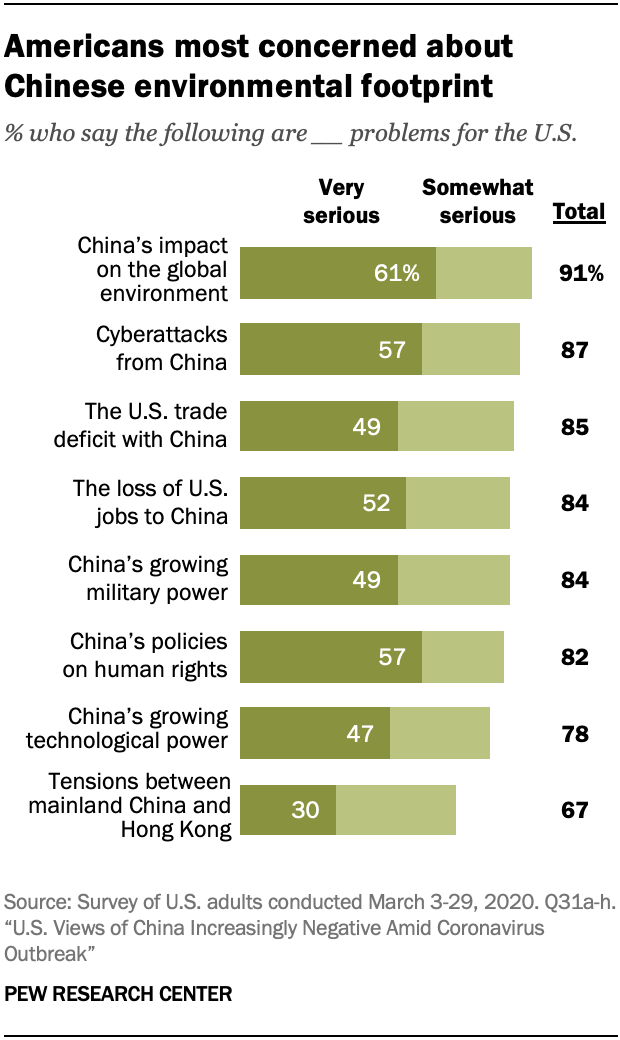
When asked whether various issues involving China pose a problem for the U.S., at least two-thirds of Americans say each is a serious concern for their country – and most issues are seen as very serious problems by roughly half or more. Topping the list is China’s impact on the global environment. A majority (61%) says China’s environmental footprint is a very serious problem for the U.S., a 10 percentage point increase from when the question was last asked in 2018. (China was recently estimated to emit roughly 30% of the world’s total amount of carbon dioxide but produces fewer greenhouse gases per capita than the U.S. does.) Those who see global climate change as a major threat are 28 points more likely than those who do not see global warming as a threat to be very concerned with China’s environmental impact.
Americans are similarly concerned with cyberattacks from China. A majority of 57% say this poses a very serious problem to the U.S. This is unchanged from 2018 but up 7 percentage points from 2012 when the question was first asked.
Similarly, 57% say China’s human rights policies pose a very serious problem – an 8-point increase from 2018.
Economic and military issues trigger slightly lower, though still high, levels of concern for Americans. The loss of U.S. jobs to China is seen as a very serious problem by 52% of Americans, but this has fallen from 71% who called it a very serious issue in 2012. The U.S. trade deficit with China – which recently shrank for the first time in half a decade – is also considered a very serious problem by about half in the U.S. (49%), a decline of 12 percentage points since 2012. Another 49% say China’s growing military power is a substantial concern.
As the U.S. keeps its market closed to the Chinese telecommunications giant Huawei and raises alarms about the security of Chinese technology, about half of U.S. adults (47%) are concerned about China’s growing technological power. China has also recently overtaken the U.S. as the world’s top producer of patent applications.
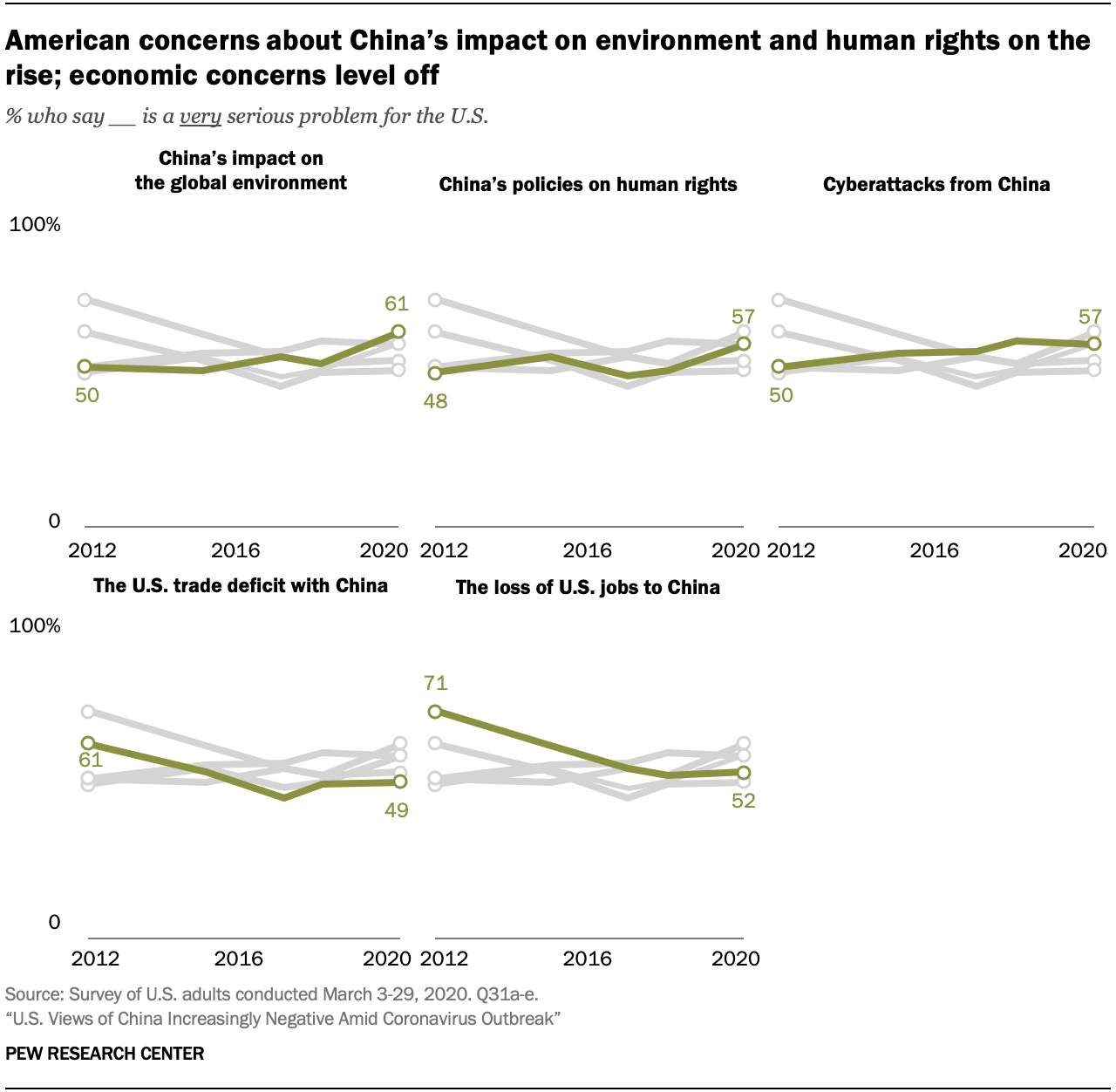
Widespread protests over an extradition bill’s potential effects on Hong Kong’s judiciary independence erupted across the special administrative region last year. But tensions between mainland China and Hong Kong are the least concerning to Americans of the issues polled. Only three-in-ten consider this issue a very serious problem for the U.S.
Concern about each of these issues generally coincides with less favorable overall views of China. For instance, among those who say China’s growing military power is not too serious a problem or not a problem at all, 47% have a favorable view of China. But, among those who believe China’s military strength poses a very serious threat to the U.S., just 19% see China favorably.
Evaluations of these issues tend to differ based on individuals’ concerns about other threats. Those who say the condition of the global economy poses a major threat to the U.S. are more likely to rate most issues in the China-U.S. relationship as very serious problems. For instance, about six-in-ten (58%) of those who see international economic conditions as a major threat are also very concerned about America’s trade deficit with China. On the other hand, 39% of those who consider the economy a minor threat are very concerned about the deficit – a 19 percentage point difference.
People who are at least somewhat concerned about these issues are also more likely to see China as a major threat than those who do not see the issues as serious problems. For example, when looking at China’s growing military power or its growing technological power, those who see either as a serious problem for the U.S. are 46 percentage points more likely to say that China’s growing power and influence pose a major threat to the U.S. The difference is smallest when looking at the U.S. trade deficit with China, but even then, those who see the deficit as a serious problem are 23 points more likely to see China as a major threat.
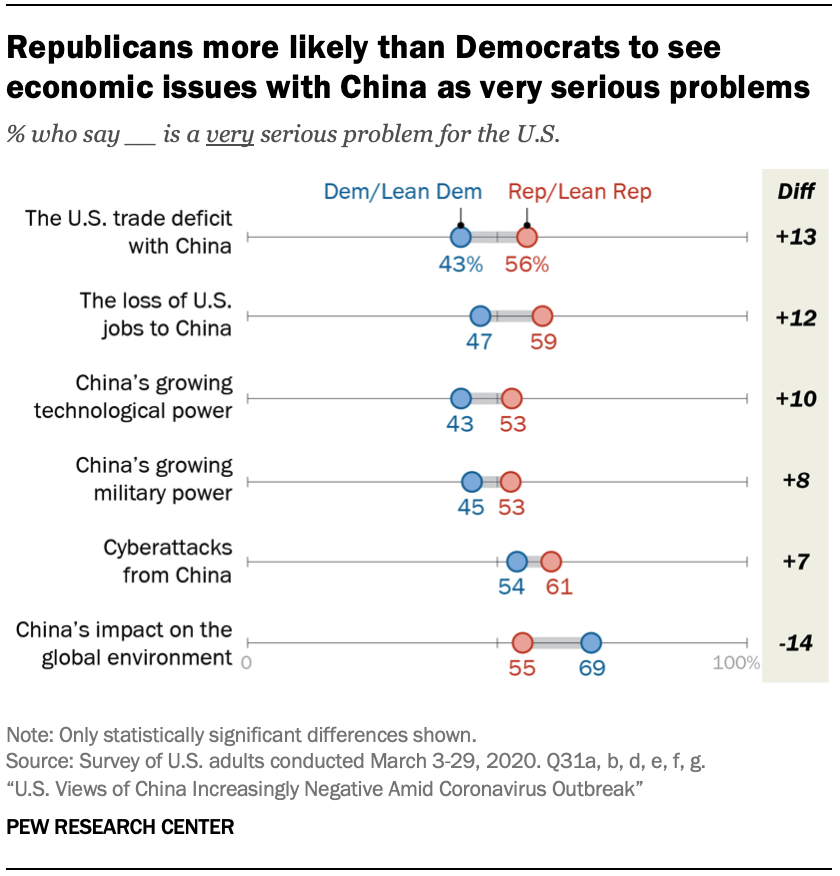
Additionally, a partisan gap exists when evaluating certain issues in the Sino-American relationship. Republicans and Republican-leaning independents are more likely than Democrats and Democratic-leaning independents to see the U.S. trade deficit with China, the loss of U.S. jobs to China and China’s growing technological capabilities as very serious problems. The same divide exists over China’s growing military power and cyberattacks from China. What’s more, Republicans have become more concerned about the U.S. trade deficit with China since last polled on the topic in 2018, when the latest U.S.-China trade war began. Concern for the trade deficit among Democrats did not change over that same time. China’s environmental impact is the only issue that Democrats are more likely to see as a very serious problem: Concern among Democrats on this issue has increased by 14 percentage points since 2018. Still, both sides of the aisle share the same level of concern for tensions between mainland China and Hong Kong and China’s human rights policies.
Older Americans are more likely than their younger counterparts to see several of these issues as major problems. Evaluations of China’s growing military power evoke the greatest generational divide. While 61% of those ages 50 and older see China’s growing military power as a very serious problem, 32% of those ages 18 to 29 say the same – a difference of 29 percentage points. Similar divides accompany opinions on cyberattacks from China (27 points) and China’s growing technological prowess (25 points). Notably, similar majorities across all age groups see China’s environmental impact as a very serious problem.
Majority sees U.S. as leading economy, but perceptions colored by financial views
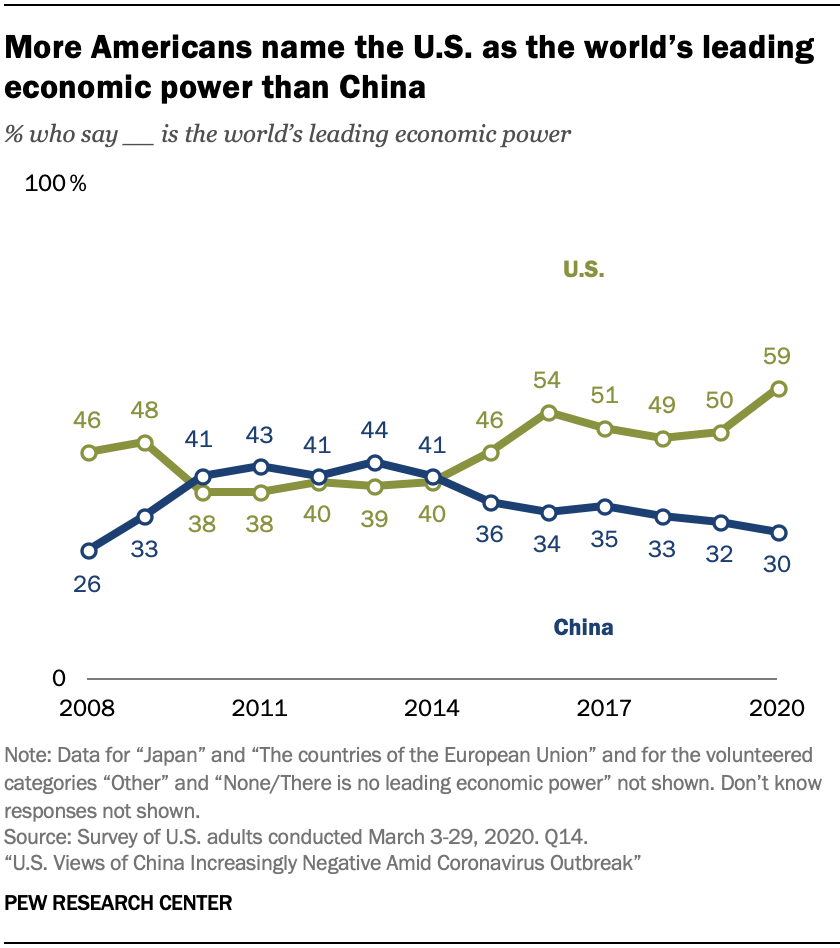
China’s economic growth has slowed in recent quarters, and the U.S. stock market logged one of its worst first quarters in history amid the spread of COVID-19. Even though unemployment surged in the U.S. throughout the March field period, marking the worst period for jobs since the 2008 recession, Americans’ sense that the U.S. is the world’s top economy has grown precipitously. Today, when asked to choose between the U.S., China, Japan and the countries of the European Union as the world’s leading economic power, 59% of Americans choose their own country, up from 50% last year. This is both the largest share to name the U.S. and the largest year-on-year increase since the question was first asked in 2008. Only three-in-ten name China, and this is largely unchanged over recent years.1
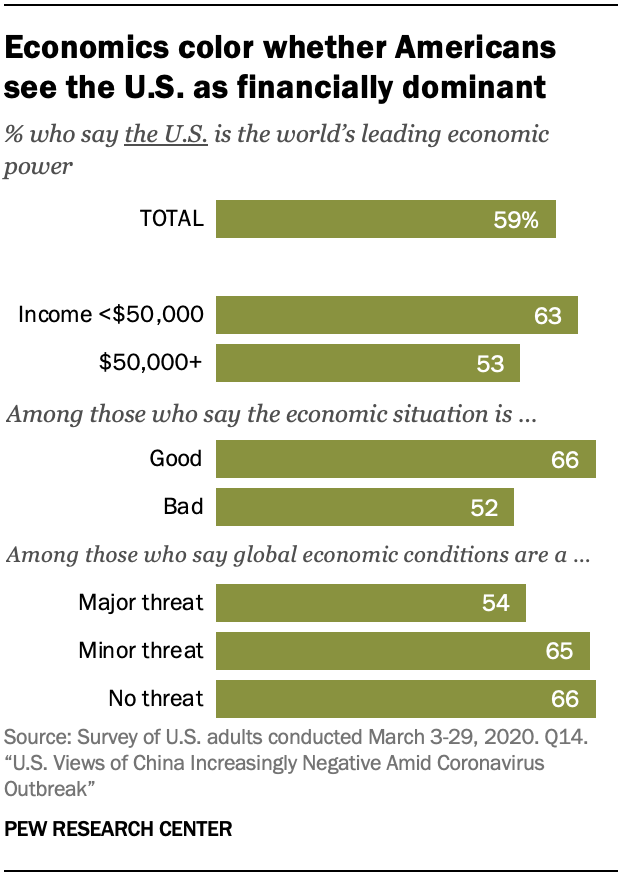
People’s personal economic situations, as well as concerns about both the domestic and global economy, color their sense of how the U.S. economy rates on the world stage.
Those who have higher incomes are more likely than those who are less well-off to say the U.S. is the world’s leading economic power (63% vs. 53%). The same is true of those who say their country’s economic situation is good compared with those who say the opposite (66% vs. 52%). And those who say the condition of the global economy is a major threat to the United States are less likely to see the U.S. as economically superior (and more likely to name China) than those who see it as a minor threat or no threat at all.2
Those who see China’s power and influence as a major threat are also more likely to name China as the world’s leading economy than those who see it as less of a threat.
Older Americans are more likely than younger Americans to say the U.S. is the leading economic power: 63% of those ages 50 and older name the U.S., while fewer than half (47%) of those ages 18 to 29 do the same. Americans younger than 30 are not only more likely to name China as the world’s leading economy than older Americans (38% vs. 26%), but they are also more likely to name the countries of the EU (9% vs. 2%).
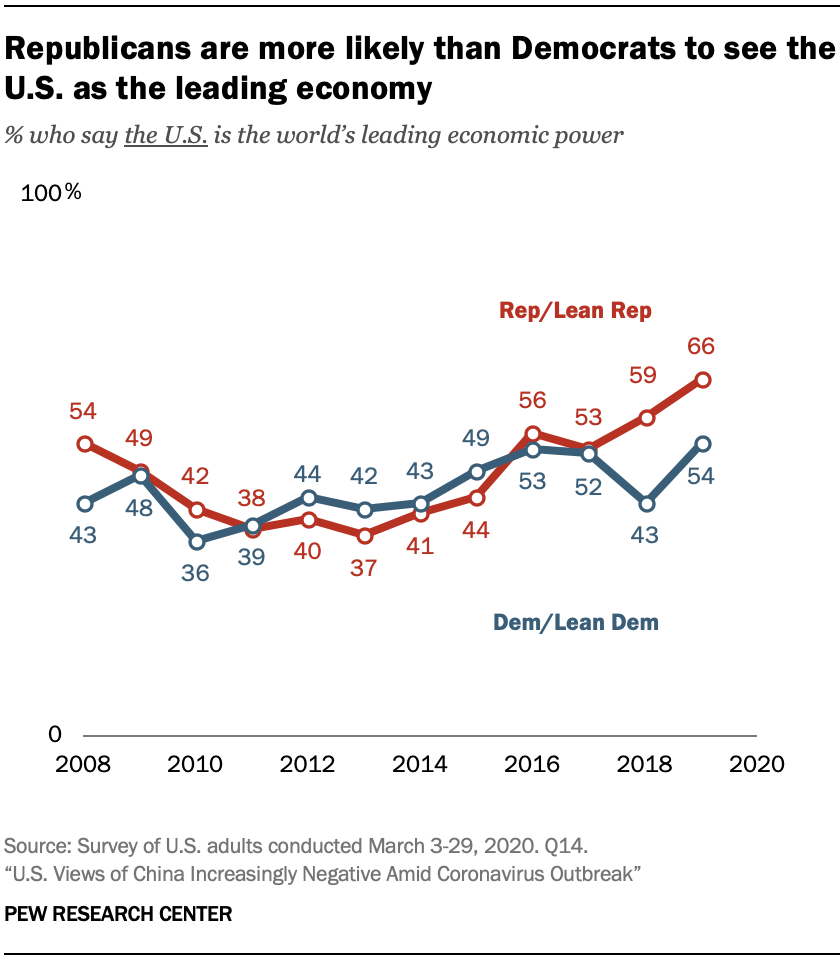
Partisanship is also related to how Americans evaluate the world’s top economic power. While both Republicans and Democrats are more likely to name the U.S. as the world’s leading economic power than China, Republicans and Republican-leaning independents are particularly convinced of America’s economic superiority. Republicans and those who lean Republican are more than twice as likely to name the U.S. as they are China (66% and 27%, respectively), whereas Democrats and Democratic-leaning independents name the U.S. at a lower rate (54% and 33%, respectively). And, while partisanship also colored views of which economy was strongest last year, this gap is relatively new.
Widespread sense that U.S. is militarily dominant, should lead globally
When it comes to which country is the world’s leading military power, more than eight-in-ten Americans agree that it’s the U.S., up 11 percentage points since the question was last asked in 2016. Only 6% name China, a 6-point decrease. Similarly, few name Russia (8%), a view largely unchanged since four years ago.
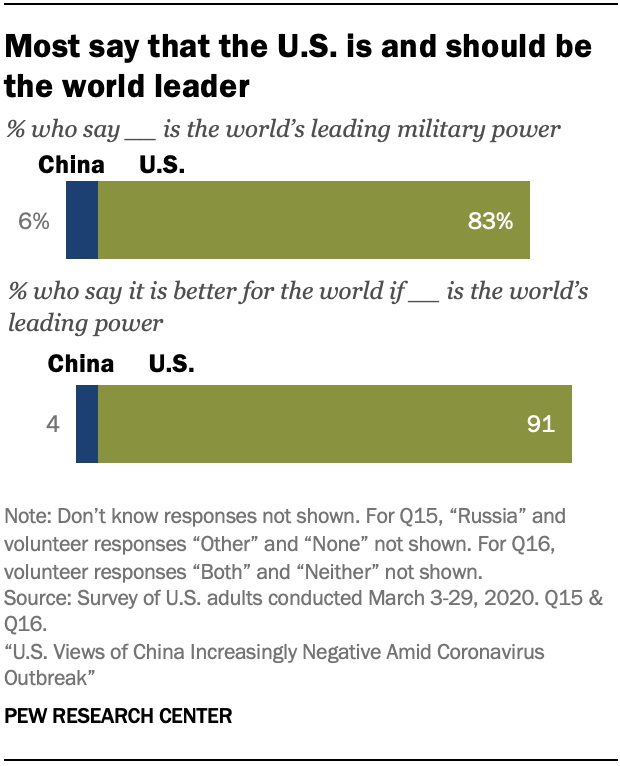
Republicans and Republican-leaning independents are more likely to name the U.S. as the leading military power than Democrats and Democratic leaners (90% vs. 80%). While Democrats are about as likely as Republicans to name China, they are somewhat more likely to name Russia as the world’s leading military power (9% vs. 4%).3 Men, those with higher incomes and those with higher levels of education are more likely to say the U.S. is the leading military power than women, the less affluent or less educated people, respectively, though differences between people of different educational backgrounds are muted.
Regardless of whether they think the U.S. is the leading economic or military power today, nearly all Americans also think that a future with U.S. leadership is a better thing than one with Chinese leadership. When forced to choose between which would be better for the world, 91% of Americans say it is better for the U.S. to be the world’s leading power than China (4%), largely unchanged since 2018 when the question was last asked. While there is widespread agreement across all groups in society, Republicans and those who see China’s power and influence as a major threat are more likely than Democrats and those who feel less threatened to value U.S. global leadership.